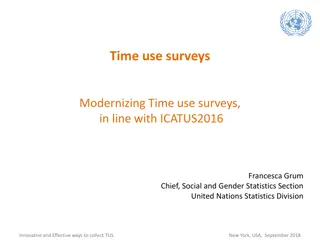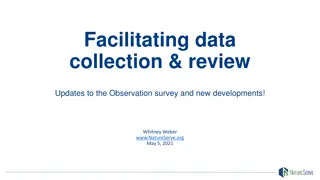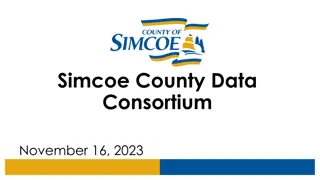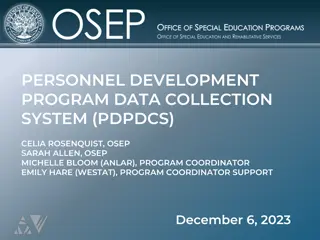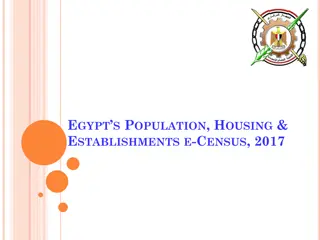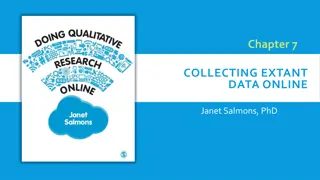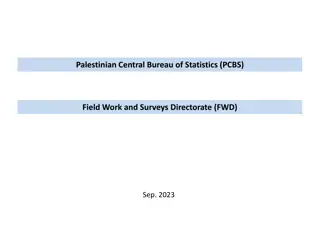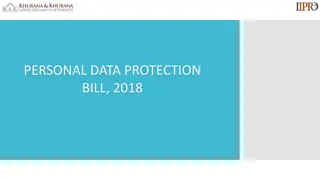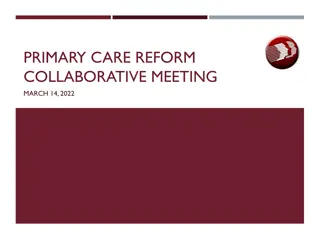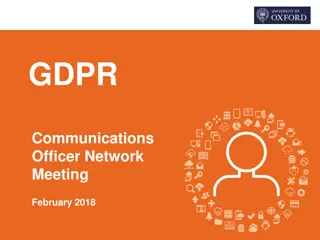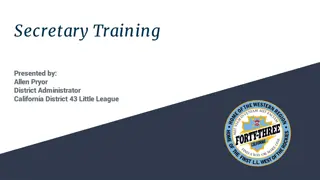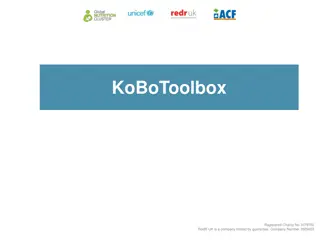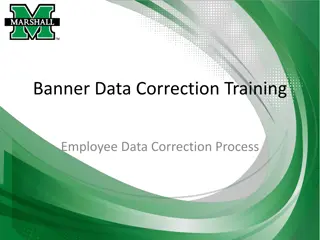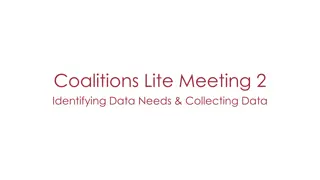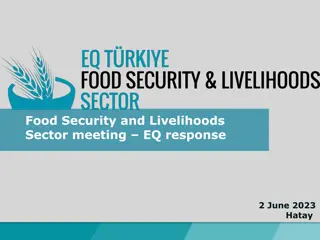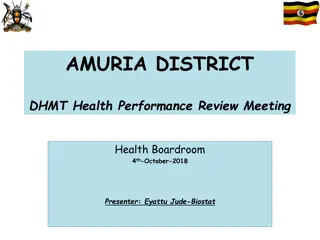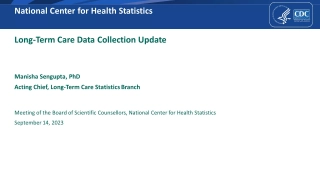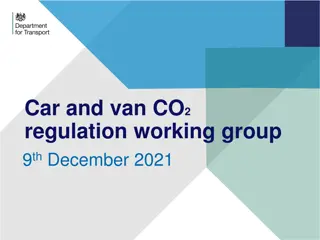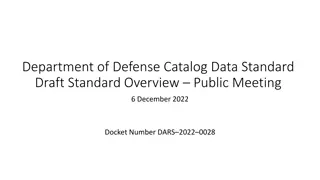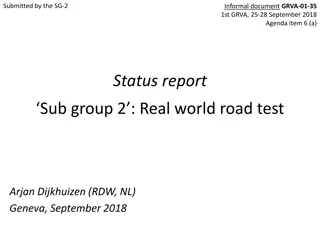Listen Up! 2-Day Data Collection Start-Up Meeting Overview
A comprehensive overview of the 2-day data collection start-up meeting for the Listen Up! project and Barometer. The meeting aims to equip participants with an understanding of project goals, data collection tools, feminist principles, and humanitarian response measures. Topics covered include core concepts of gender-based violence, feminist data collection basics, ethical considerations, team roles, and group agreements. The history and purpose of the Listen Up! project and Barometer are also detailed, emphasizing empowerment and prevention of sexual harassment and abuse in humanitarian settings.
Download Presentation

Please find below an Image/Link to download the presentation.
The content on the website is provided AS IS for your information and personal use only. It may not be sold, licensed, or shared on other websites without obtaining consent from the author. Download presentation by click this link. If you encounter any issues during the download, it is possible that the publisher has removed the file from their server.
E N D
Presentation Transcript
2-Day Data Collection Start-Up Meeting Listen Up! Barometer [Location] [Date] [Organization(s)]
Meeting Outcomes By the end of the 2 days, participants will have: An understanding of the Listen Up! Project and the Barometer An understanding of the purpose and use of all data collection tools and an agreed upon understanding of collecting data aligned with feminist principles Group agreements on roles, responsibilities, safety, security and best practices
Overview: Agenda 1. What is the Listen Up! Project and Barometer? 2. Review of gender-based violence (GBV) core concepts, guiding principles and survivor- centered support 3. Terminology and language 4. Basics of feminist data collection 5. Data collection: review and practice of the tools 6. Ethical and safety considerations and security 7. Roles and responsibilities of each Barometer team member 8. Group Agreements and Code of Conduct 9. Review of the GBV referral pathways and contacts 10. Review of key humanitarian documents
What is the Listen Up! Project and Barometer?
Overview Listen Up! Project Barometer: What is it? What is its purpose? Minimum standards that have guided the Barometer development Theory of Change Who is the Barometer for and when do we use it? How do we measure a humanitarian response using the Barometer?
The Listen Up! Project History Project goal: Amplify the voices and power of refugee and host community women and girls to catalyze institutional reform, interagency action, and increased resources with the goal of reducing sexual harassment, exploitation and abuse (SHEA) of women and girls in humanitarian settings. Listen Up! implemented across different contexts in collaboration with women s rights organizations under three objectives. Under objective 1, Listen Up! aims to establish an Index that measures action to address GBV and SHEA prevention and response in humanitarian contexts. Listen Up! is guided by feminist principles, including the belief that the humanitarian system needs to fundamentally transform to truly prevent SHEA of women and girls affected by crisis and women at work in emergencies.
The Listen Up! Barometer A planning and assessment tool that examines the lived experiences of women and girls to determine if the environment of a humanitarian emergency response is able to prevent, mitigate and respond to GBV, sexual exploitation and abuse, and sexual harassment. A rapid assessment of strengths and weaknesses of a humanitarian response for women and girls, including those working within humanitarian emergencies and those in the catchment area of an emergency response, for the purpose of creating recommendations for advocacy. An advocacy tool for women s groups, organizations and networks, and other GBV actors, to hold those responsible for humanitarian responses accountable to women and girls.
Minimum standards This Barometer was developed based on existing minimum standards around prevention of and response to GBV, sexual harassment, and sexual exploitation and abuse. These minimum standards are established global inter-agency best practices. They include: Interagency GBV Minimum Standards for Gender-Based Violence Programming in Emergencies IASC Guidelines for Integrating GBV Interventions in Humanitarian Action Prevention of Sexual Exploitation and Abuse Minimum Operating Standards IASC Best Practice Guide Inter-Agency Community-Based Complaints Mechanisms GBV Accountability Framework
Theory of Change Women and girls affected by crisis and women at work in emergencies pursue their potential, free from violence and inequality. VISION 1. Women and girls trust and access safe, confidential, accountable support services when they experience GBV, including sexual harassment, exploitation and abuse. 2. Women and girls have equal access and control over humanitarian services and resources. Humanitarians use power positively and respect and value women and girls. 3. The humanitarian system prioritizes, resources and values efforts to address sexual harassment, exploitation and abuse 4. Humanitarian organizations hold staff accountable to address sexual harassment, exploitation and abuse OUTCOMES
Who is the Barometer for and when do we use it? Who is it for? o Women s right actors, groups, organizations and networks at the national, local, community and grassroots levels o Working in partnership with a GBV humanitarian actor When to use it? Whenever women and girls and allies within the humanitarian system are concerned that humanitarian action is harming women and girls, and/or that there is insufficient humanitarian action to ensure safe and equitable access to humanitarian aid for women and girls. It can be used on a one-off basis or periodically to ethically document women s and girls lived experiences in a humanitarian response, for use in advocacy with humanitarian leadership, donors and humanitarian actors.
How do we measure a humanitarian response using the Barometer? The Barometer uses 4 data collection tools and guides to collect data you will use to score the humanitarian response: Focus Group Discussion (FGD) Guide: Discussions with women and girls Key Informant Interview (KII) Guide: Interviews with local women s groups, organizations and networks Observational Checklist: A checklist that observes (1) documents on GBV and prevention of sexual exploitation, abuse and sexual harassment, and (2) the humanitarian response environment. Staff Perception Survey: A survey for humanitarian workers (female and male)
How do we measure a humanitarian response with the Barometer? The Barometer assesses 4 areas of a humanitarian response that correspond with the 4 outcomes of the Theory of Change. The Barometer uses a traffic light system (Red, Orange, Yellow, Green) to score the status of a GBV and prevention of sexual harassment and sexual exploitation and abuse humanitarian response across those 4 areas (from the Observational Checklist and Staff Perception Survey). It also draws from qualitative, narrative data to add nuance and detail to those scores (from FGDs and KIIs). Each humanitarian emergency assessed with this Barometer will be given an overall score and individual scores for each outcome area. Overall rating scores Strong achievement of all criteria; represents good practice and a strong ability of the humanitarian aid environment to prevent and respond to GBV, including sexual exploitation and abuse and sexual harassment; exceeds minimum standards 91-100% Satisfactory achievement across most criteria; represents demonstration of ability to prevent and respond to GBV, including sexual exploitation and abuse and sexual harassment; meets minimum standards 67-90% Limited achievement across most criteria; demonstrates some ability to prevent and respond to GBV, including sexual exploitation and abuse and sexual harassment; improvements needed to ensure minimum standards are met 51-66% Insufficient achievement across the criteria; humanitarian aid environment not adequately preventing and responding to GBV, including sexual exploitation and abuse and sexual harassment; clear strategic planning is necessary to improve policy and practice; below minimum standards 0-50%
Review of GBV core concepts, guiding principles, and survivor-centered support
ROOT CAUSES of GBV ROOT CAUSES Lack of belief in human rights for all, that women s and girls lives are less valuable than those of men and boys Inequality between men and women across all aspects of life Male abuse of control and POWER OVER women and girls Men s position of power, privilege and entitlement over women Patriarchy
Core types of GBV Sexual Assault Rape FORMS/TYPES Denial of resources, opportunities or services Physical Assault Forced Marriage/ Harmful Traditional Practices Psychological/ Emotional Abuse
CONTRIBUTING FACTORS of GBV Availability of food, fuel, income generation Breakdown of social structures Alcohol/ drug abuse EXACEBATING FACTORS Poverty Collapse of traditional society and family support system Religious, cultural and/or family beliefs and practices Lack of police protection; lack of laws protecting against GBV Conflict Boredom and lack of services, activities or programs Loss of male power/ role in family and community Men seeking to assert power Impunity Leadership predominantly male Tool/ strategy of war Retaliation Lack of education For more examples of contributing factors see: IASC Guidelines for Integrated Gender-based Violence Interventions in Humanitarian Action (2015)
CONSEQUENCES OF GBV EFFECTS/CONSQUENCES Physical Psychological Social Death Suicide PTSD Depression Rejection/ ostracization from family Isolation Injuries during pregnancy Anxiety, fear Serious injuries Self-blame Social rejection/ ostracization Family breakdown Unwanted or early pregnancy STIs, incl. HIV/AIDs Shame Self-hate Withdrawal from social life Unsafe abortion complications Social stigma Vulnerability to disease Suicidal thoughts Impact on children Acute or chronic illness Infant mortality
1. Tree of oppression of women and girls 2. Tree of empowerment for women and girls
Guiding Principles of VAWG/GBV Respect/ right to dignity and self- determination Right to confidentiality Right to safety Non-discrimination
Guiding Principles Right to safety Physical and emotional safety ALL of our actions prioritize and safeguard the well-being of all women and girls, including survivors
Guiding Principles Right to confidentiality Safe and confidential referrals When making a referral, only relevant details are shared, and only with the permission of the woman, girl or survivor Information on women and girls who access the Centers must not be shared Sharing information happens on a need-to-know basis or in line with center protocols, or laws and policies Permission is obtained from women and girls before sharing information Photos and videos are not taken in the Centers
Guiding Principles Respect: Right to dignity and self-determination Validating, non-blaming and non-judgmental approach for all women and girls Value women and girls, including survivors, and care about their experience, history and future Women and girls, including survivors, make their own decisions about support, services and care and this is valued and upheld in the Centers
Guiding Principles Non-discrimination Every adult or child, regardless of her/his sex, should be accorded equal care and support All women and girls, including survivors, should receive equal and fair treatment, care and support regardless of their race, religion, nationality or sexual orientation
Focused on power- within, power-with, and power-to, and solidarity among women Informed by an understanding of what works for women and girls Underpinned by feminism and a feminist analysis of the world and anti- oppressive practice Located within women and girl only safe spaces and environments Recognizes and confronts the impact on women and girls lives of class, race, sexual orientation, disability, etc. Shaped by an understanding of women s and girls realities Women s and girls liberation from violence, discrimination and oppression at the heart Focused on women s and girls needs, interests, priorities and lived experiences Women, Girl and Survivor Centered
Has a structural analysis of power and inequality underpinning it Feminist Data Collection Rooted in social justice Values, centers and promotes women and girls as knowledge creators, their experiential knowledge and their naming of experience Prioritizes voices of the marginalized or disadvantaged Participatory & inclusive Focused on using data for advocacy, NOT donor reporting!
Feminist Data Collection What are our shared definitions in this work? Feminist approaches include having a shared understanding of definitions from the outset!
Review of GBV Words, Terms and Definitions Ask a group to list all of the GBV words, terms and definitions that may come up during data collection. Bring in the international definitions of these and discuss them. Then think about how the team will convey these accurately in the language(s) that will be used during data collection. Make a note of these when you agree on them, so that the whole team has copies for the data collection.
Standard Definitions GBV Domestic violence Intimate partner violence Sexual violence Sexual harassment Sexual exploitation and abuse [Others that the group raises that may come up during the data collection ]
Note-Taking Review of documents Guidance for Note-Takers FGD Notes Template KII Notes Template
FGD Tools Review of both tools and discussion/Q&A Who will use this tool? Let s practice!
Staff Perception Survey Tool Review of both tools and discussion/Q&A Who will use this tool? Let s practice!
Observational Checklist Tool Review of both tools and discussion/Q&A Who will use this tool? When might you use this tool and discussion on focus areas
KII Tool Review of both tools and discussion/Q&A Who will use this tool? Let s practice!
Note-Taking Quick revisit to what we learned about note-taking Do you feel comfortable with what needs to happen? Q&A
Implementation Schedule [Add details regarding your specific: schedule, including locations, target groups, times, logistics, data collection activities, etc.]
Ethical and Safety Considerations and Security
Safety and Security Confidentiality and privacy Data protection Informed consent Security risks, benefits and considerations Security assessments, procedures and protocols Safe identification and referrals to services and support when survivors disclose during the Barometer implementation
Safety and Security [Add the main points from your security protocol here] Let s practice!
Team Roles Team Leader Facilitator Note-Taker/ support Interpreter GBV Case Worker/ Manager/ Responder
Assigning Data Collection Activities Assign names to the different activities in data collection schedule. Discuss who will taking each activity.
Group Agreements and Code of Conduct
Group Agreements Check and make sure it is clear what each team member is doing and that all are in agreement. Important areas for discussion for agreement Q&A
Code of Conduct [Insert the main points of your code of conduct here and review with the team]






